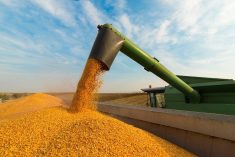Chicago | Reuters — Chicago wheat futures traded both sides of unchanged on Tuesday, holding near a March high underpinned by concerns over U.S. crop conditions. Traders also awaited the outcome of a call between the leaders of the U.S. and Russia over the war in Ukraine.
Meanwhile, corn futures fell as traders awaited planting intentions data from the U.S. Department of Agriculture, and corn and soy dipped on responses to recent U.S. tariffs that could impact U.S. agricultural products.
The most active May wheat contract on the Chicago Board of Trade fell 3-1/2 cents at $5.65 a bushel.
Read Also

U.S. livestock: Chicago cattle futures mixed ahead of Thanksgiving holiday
Chicago | Reuters – Chicago Mercantile Exchange’s live cattle futures were mixed on Tuesday, with nearby contracts extending the previous…
The contract rose on Monday to its highest since February 27 after reports of dust storms and high winds over the weekend in the U.S. Central and Southern Plains brought attention to drought conditions in the region and their impact on the wheat crop, said Arlan Suderman, chief commodities economist at StoneX.
In data published after Monday’s market close, the U.S. Department of Agriculture rated 48 per cent of the winter wheat in top-producing state Kansas as good-to-excellent, down from 52 per cent the previous week.
Meanwhile, investors are monitoring the results of a call between U.S. President Donald Trump and Russian President Vladimir Putin for any progress toward a ceasefire in Ukraine.
An end to the conflict is seen as potentially bearish for grain prices, according to analysts, as it could ease security and sanctions constraints on exports from Ukraine and Russia.
Tightening supplies and government export restrictions have slowed shipments from Russia in recent weeks, and Suderman said the boost to U.S. exports is already becoming apparent.
The USDA on Monday reported higher-than-expected weekly export inspections for wheat, while corn and soybean volumes were within a range of trade estimates.
CBOT soybeans fell 2-3/4 cents to $10.12-3/4 a bushel and CBOT May corn fell 2-1/4 cents to $4.58-3/4 a bushel.
Corn faces pressure from an expected increase in acreage when the USDA releases its prospective plantings report on March 31, said Suderman, while corn and soy futures were weighed on by fears of retaliation against U.S. tariff policies by impacted countries like Mexico.














